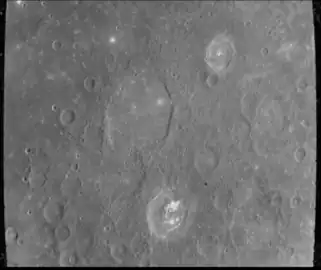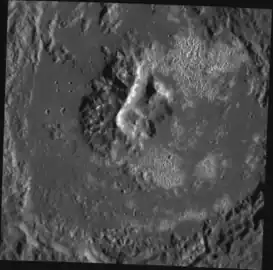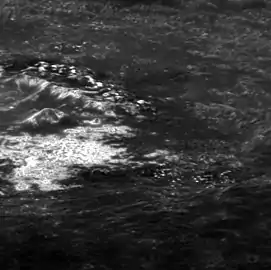 MESSENGER image | |
| Planet | Mercury |
|---|---|
| Coordinates | 3°53′N 148°54′W / 3.89°N 148.9°W |
| Quadrangle | Tolstoj |
| Diameter | 97 km (60 mi) |
| Eponym | Tyagaraja |
Tyagaraja is a crater on Mercury. Its name was adopted by the International Astronomical Union in 1976. Tyagaraja is named for the Indian composer Tyagaraja.[1]
Tyagaraja is the third-largest crater of the Kuiperian system on Mercury, at 97 km diameter, after Bartók crater and Amaral crater.[2]
Hollows are present within Tyagaraja. Within the extensive hollows of Tyagaraja is a dark spot of low reflectance material (LRM), closely associated with the central peak complex.[3] Another prominent dark spot is located to the southwest of Tyagaraja, on the north rim of an unnamed crater.
The larger Phidias is to the north, and the crater Stevenson is to the east.
 Mariner 10 image with Tyagaraja at bottom
Mariner 10 image with Tyagaraja at bottom The interior of Tyagaraja, showing its hollows
The interior of Tyagaraja, showing its hollows Oblique view also showing the hollows
Oblique view also showing the hollows
References
- ↑ "Tyagaraja". Gazetteer of Planetary Nomenclature. NASA. Retrieved 14 January 2020.
- ↑ Denevi, B. W., Ernst, C. M., Prockter, L. M., and Robinson, M. S., 2018. The Geologic History of Mercury. In Mercury: The View After MESSENGER edited by Sean C. Solomon, Larry R. Nittler, and Brian J. Anderson. Cambridge Planetary Science. Chapter 6, Table 6.4.
- ↑ Zhiyong Xiao, Robert G. Strom, David T. Blewett, Paul K. Byrne, Sean C. Solomon, Scott L. Murchie, Ann L. Sprague, Deborah L. Domingue, Jörn Helbert, 2013. Dark spots on Mercury: A distinctive low-reflectance material and its relation to hollows. Journal of Geophysical Research Planets. doi.org/10.1002/jgre.20115
This article is issued from Wikipedia. The text is licensed under Creative Commons - Attribution - Sharealike. Additional terms may apply for the media files.